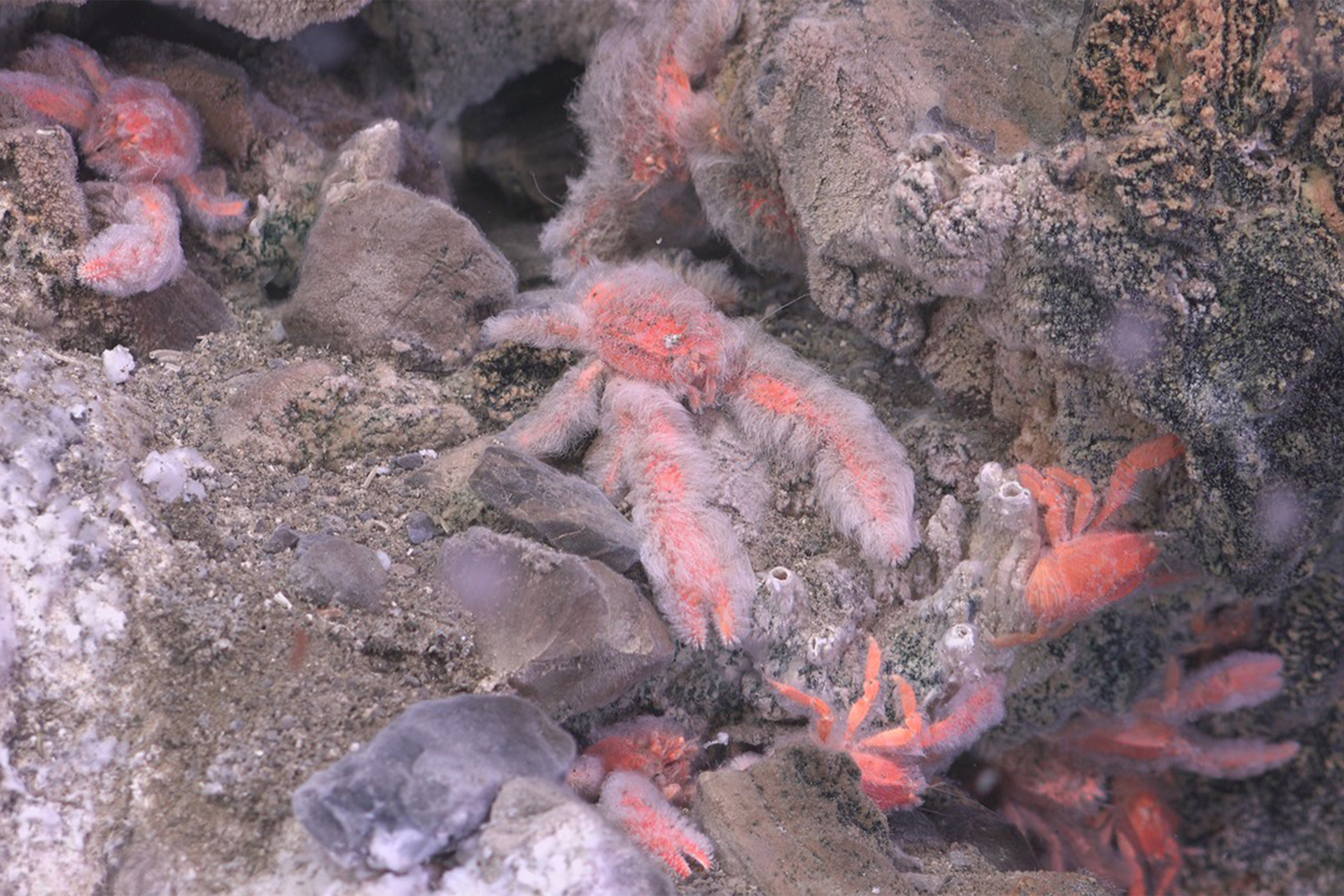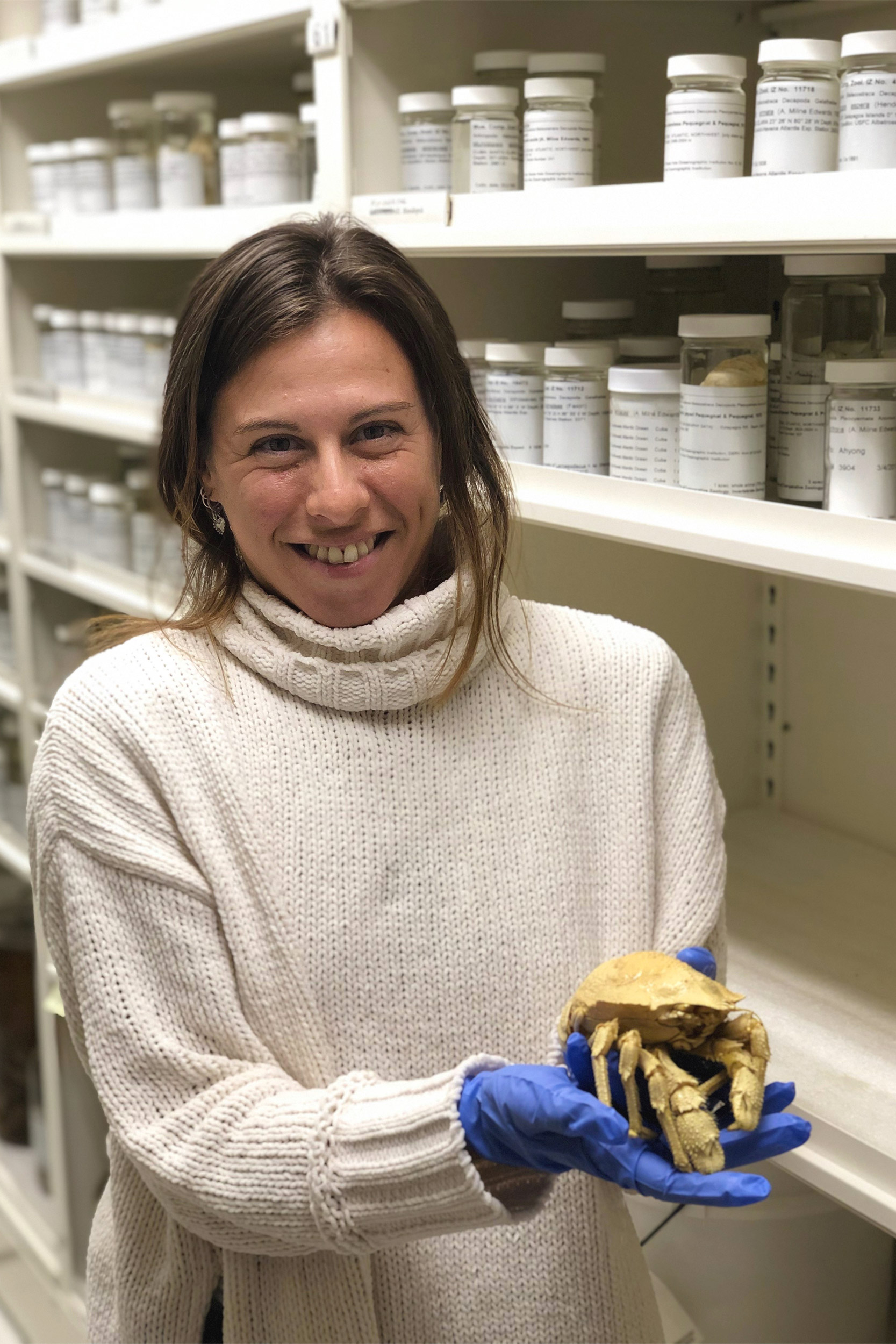
One of the new species of squat lobster, Munidopsis girguisi, is found off the coast of California. This particular squat lobster was named in honor of Peter Girguis, a professor of organismic and evolutionary biology at Harvard.
Credit: Schmidt Ocean Institute
Racing to catalog, study deep-sea biodiversity
Researchers find 5 new species of hard-to-access creatures amid shortage of knowledge, concerns growing commercial interest may cause extinctions
Paula Rodríguez-Flores has always been obsessed with invertebrates. “Like really, really obsessed,” said the biodiversity postdoctoral fellow, who works in Harvard’s Museum of Comparative Zoology.
As a youngster in her native Madrid, Rodríguez-Flores captured beetles in jars and brought her finds to bed with her. By college, she had turned her attention to seabound invertebrates such as sea sponges, urchins, shrimp, and squat lobster, Rodríguez-Flores’ specialty. In a new study published in Invertebrate Systematics, she and a team of researchers identified five new species of deep-sea squat lobsters in the Munidopsidae family. There are more than a thousand known species of squat lobster — which are closer to hermit crabs than the Maine lobster — and dozens more new species are discovered every year, which suggests their true diversity is still poorly understood.
Now, with this latest discovery of new species (one of which is called Munidopsis girguisi in honor of Peter Girguis, a professor of organismic and evolutionary biology at Harvard), the study’s authors call for a reclassification of all squat lobster species to better capture their geographic distribution and evolutionary history. This change is important for more than just the squat lobster: Many of the creatures lurking in the ocean’s depths remain a mystery, and new human activities, like ocean floor mining, could soon threaten their very existence. All of which adds urgency to scientists’ desire to discover and study these animals before it’s too late.
“Deep-sea diversity is really, really unknown,” said Rodríguez-Flores. “We know maybe 10 percent, or even less, of the marine fauna. It’s the most unexplored habitat in the world.”
With industries eager to explore the economic potential of this area, the deep-sea knowledge gap could come with a price: “People want to explore the deep ocean without knowing what is in this area,” Rodríguez-Flores said. “If we don’t research this, maybe some species will go extinct when this exploitation starts.”

Her study, which was a collaboration between Gonzalo Giribet, a professor of organismic and evolutionary biology and director of the Museum of Comparative Zoology, and the Scripps Institution of Oceanography, represents a welcome contribution to the limited body of knowledge, resulting in part from hurdles to doing research at extreme ocean depths.
The squat lobsters Rodríguez-Flores and her team identified live about 2,000 to 5,000 kilometers, or about 3 miles, below the ocean’s surface. “It’s really cold, really deep, a lot of pressure, and scattered food,” Rodríguez-Flores said, making it a challenge for any creature (as well as deep-sea exploration technologies) to survive.
Four of the new species — which are, like many deep-sea creatures, ghost-white and near-blind — were found using remotely operated vehicles and a human-occupied vehicle called Alvin, which explored hydrothermal vents, cold seeps, and other seafloor habitats in the Galapagos, Costa Rica, and California over the last decade.
But the fifth was a surprise.
When Rodríguez-Flores joined the MCZ, she studied the museum’s collection of squat lobster specimens, focusing on those in the family Munidopsidae. That group lives almost exclusively in deep-sea continental shelves, slopes, and in the abyssal zone — the area 3,000 meters or more below the ocean’s surface.
Squat lobsters can live almost anywhere — in shallow waters, coral reefs, deep-sea hydrothermal vents — and come in a whole rainbow of colors, some of them kind of psychedelic. One species, for example, is fuchsia with purple polka dots; another is lemon-yellow with a white racing stripe along its back.
“Deep-sea diversity is really, really unknown. We know maybe 10 percent, or even less, of the marine fauna. It’s the most unexplored habitat in the world.”
Paula Rodríguez-Flores
But the comparatively humdrum deep-sea Munidopsidae family is hard to study because scientists have only been able to collect a small number of specimens, and these are scattered across the world. Rodríguez-Flores could only learn so much from Harvard’s collection.
Luckily, the Smithsonian and Scripps Institutions had what she needed. And at Scripps, Rodríguez-Flores not only gathered more data on the species, but also found that one specimen, collected in 1990, was an entirely new one. Using both DNA sequencing and micro-CT scans, she and her collaborators then studied how these new species related to the many other squat lobster families living worldwide.
“To understand the evolutionary history of squat lobsters, we have to compare, genetically and morphologically, all the species that we know,” said Rodríguez-Flores. “And we have found that the current taxonomic classification does not reflect the evolutionary history, so we have to revise the classification.”
The findings included the possibilities that deep-sea squat lobsters might include fewer species than previously thought and colonized a wider geographic region within the seemingly barren abyssal zone.
Such a big taxonomic overhaul takes time, travel, and money. Rodríguez-Flores has spent years visiting collections all over the world to examine as many specimens as she can. And yet, that labor is what helped unearth the five new species, which she and the team named after three of their international collaborators, one of the exploration vessels (Nautilus), and Girguis, who helped collect the species that now bears his name.
“He was very excited to collect this species because it’s really special,” said Rodríguez-Flores. “It’s pink and fuzzy. They are so cute.”
They might be cute, but they’re not so tasty, a fact the authors felt compelled to include in their study because, as Rodríguez-Flores said, they get asked all the time. “Everyone asks me if I eat these crustaceans,” she said. “They can be tasty if you use them for soup, but they’re not like lobster. They’re almost all legs.”
Tasty or not, Rodríguez-Flores craves more squat lobster. She’s hoping to publish a new proposed taxonomy within the next year and will continue searching for the expected two-thirds of species that remain in the dark.
“We still do not know how many species live in our world,” she said, speaking of not just her latest invertebrate love, the squat lobster, but all of Earth’s creatures. “Around one million species already face a threat of extinction, and around 40 percent of all species on Earth may be threatened with or driven to extinction by the year 2100. With this current rate of extinction, it is likely that most species are going to go extinct before being discovered.”
Unless, of course, Rodríguez-Flores can get to them first.





